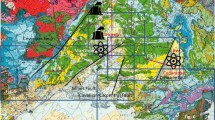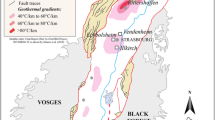Abstract
Deep fluid extraction in the Cerro Prieto geothermal field (CPGF) has caused subsidence and induced slip on tectonic faults in the Mexicali Valley (Baja California, Mexico). The Mexicali Valley is located in the southern part of the Salton Trough, at the boundary between the Pacific and North American plates. The Valley is characterized by being a zone of continuous tectonic deformation, geothermal activity, and seismicity. Within the Cerro Prieto pull-apart basin, seismicity is concentrated mainly in swarms, while strong earthquakes have occurred in the Imperial and Cerro Prieto transform faults, that are the eastern and western bound of the basin. Since 1973, fluid extraction at the CPGF has influenced deformation in the area, accelerating the subsidence and causing rupture (frequently as vertical slip or creep) on the surface traces of tectonic faults. Both subsidence and fault slip are causing damage to infrastructure like roads, railroad tracks, irrigation channels, and agricultural fields. Currently, accelerated extraction in the eastern part of CPGF has shifted eastwards the area of most pronounced subsidence rate; this accelerated subsidence can be observed at the Saltillo fault, a southern branch of the Imperial fault in the Mexicali Valley. Published leveling data, together with field data from geological surveys, geotechnical instruments, and new InSAR images were used to model the observed deformation in the area in terms of fluid extraction. Since the electricity production in the CPGF is an indispensable part of Baja California economy, extraction is sure to continue and may probably increase, so that the problem of damages caused by subsidence will likely increase in the future.










Similar content being viewed by others
References
Allis RG, Zhan X, Clotworthy A (1998) Predicting future subsidence at Wairakei field, New Zealand. Geotherm Resour Counc Trans 22:43–47
Bennett RA, Rodi W, Reilinger RE (1996) Global positioning system constrains on fault slip rates in Southern California and Northern Baja, Mexico. J Geophys Res 101(B10):21943–21960
Bilham R, Behr J (1992) A two layer model for seismic slip on the Superstition Hills Fault, California. BSSA 82(3):1223–1235
Camacho Ibarra EG (2006) Análisis de la deformación vertical del Terreno en la región de Confluencia del Sistemas de Fallas Cerro Prieto—Imperial en el Periodo 1962–2001. Tesís de Maestría, CICESE, p 135
Carnec C, Fabriol H (1999) Monitoring and modeling land subsidence at the Cerro Prieto geothermal field, Baja California, Mexico, using SAR interferometry. Geophys Res Lett 26(9):1211–1214
CFE (2006) Cerro Prieto geothermal field. CFE, Mexico
Chen CW, Zebker HA (2001) Two-dimensional phase unwrapping with use of statistical models for cost functions in nonlinear optimization. J Opt Soc Am A 18:338–351
Contreras J, Martin-Barajas A, Herguera JC (2002) Subsidence and Extensión Rates of Laguna Salada Basin, Northeastern Baja California, Mexico. In: Eos Trans. AGU 83 (47), Fall. Meet. Supll., Abstract T52C–1223, San Francisco
Davis PM (1986) Surface deformation due to inflation of an arbitrary oriented triaxial ellipsoidal cavity in an elastic half-space, with references to Kilauea Volcano, Hawaii. J Geophys Res 91(B7):7429–7438
Fialko Y, Simons M (2000) Deformation and seismicity in the Coso geothermal area, Inyo Country, California: observation and modeling using satellite radar interferometry. J Geophys Res 195(B9):21781–21793
Glowacka E (1996) Major earthquake in Mexicali valley, Mexico, and fluid extraction at Cerro Prieto geothermal field. Bull Seism Soc Am 86:93–105
Glowacka E, Gonzalez J, Fabriol H (1999) Recent vertical deformation in Mexicali Valley and its relationship with tectonics, seismcity and fluid operation in the Cerro Prieto geothermal field. Pure Appl Geophys 156:591–614
Glowacka E, Nava FA, Diaz de Cossio G, Farfán F (2001) Monitoring the response of the imperial fault to fluid extraction in the Cerro Prieto geothermal field, Baja California, Mexico. In: Van Aswegen G, Durrheim RJ, Ortlepp WD (eds) Rockbursts and Seismcity in Mines—RASiM 5, pp 143–147
Glowacka E, Nava FA, Diaz de Cossio G, Wong V, Farfan F (2002) Fault slip, seismicity and deformation in the Mexicali Valley (B.C., Mexico) after the 1999 Hector Mine Earthquake (M = 7.1). Bull Seism Soc Am 92(4):1290–1299
Glowacka E, Sarychikhina O, Nava AF (2005) Subsidence and stress change in the Cerro Prieto geothermal field, B.C., Mexico. Pure Appl Geophys 162:2095–2110
Glowacka E, Sarychikhina O, Suarez F, Mendoza R, Nava F (2006) Estudio geologico para definir la zona de hundimiento con el fin de relocalización del canal Nuevo Delta en el Valle de Mexicali. Reporte Tecnico. CICESE, Mexico, p 505
González JJ, Glowacka E, Suárez F, Quiñónez G, Guzmán M, Castro JM, Riviera F, Félix MG (1998) Movimiento reciente de la falla Imperial, Mexicali, B. C., Divulgare, Ciencia para todos, Mexicali, B. C. 6 (22):4–15
Hanssen RF (2001) Radar interferometry. Kluwer, Netherlands
Johnson NM, Officer CB, Opdyke ND, Woodard GD, Zeitler PK, Lindsay EH (1983) Rates of late Cenozoic Tectonism in the Vallecito–Fish Creek basin. Geology 11:664–667
Kampes B, Hanssen R, Perski Z (2003) Radar interferometry with public domain tools. In: Proceedings of fringe 2003: 1–5 December, Frascati, Italy
King GCP, Stein RS, Lin J (1994) Static stress changes and the triggering of earthquakes. Bull Seismol Soc Am 84(3):935–953
Lippmann MJ, Truesdell AH, Mañón AM, Halfman SE (1991) A review of the hydrogeologic-geochemical model for Cerro Prieto. Geothermics 20:39–52
Lira H (2005) Actualización del modelo geológico conceptual de yacimiento geotérmico de Cerro Prieto, B.C. Geotermia 18:37–46
Lira H, Arellano JF (1997) Resultados de la nivelación de precisión realizada en 1997, en el campo geotérmico Cerro Prieto (Informe técnico RE 07/97, CFE 1997)
Magistrale H (2002) The relation of Southern San Jacinto fault zone to the Imperial and Cerro Prieto faults. Geol Soc Am Special Paper 365:271–178
Mogi K (1958) Relations between the eruptions of various volcanoes and the deformation of the ground surface around them. Bull Earthquake Res Inst Univ Tokyo 36:99–134
Mossop AP, Segall P (1997) Subsidence at the Geysers geothermal field, N. California from a comparison of GPS and leveling surveys. Geophys Res Lett 24:1839–1842
Nava FA, Glowacka E (1999) Fault slip triggering, healing, and viscoelastic afterworking in sediments in the Mexicali_Imperial Valley. Pure Appl Geophys 156:615–629
Ocampo-Diaz J (2005) Cerro Prieto IV, the newest power plant in Cerro Prieto geothermal field. In: Proceedings of thirtieth workshop on geothermal reservoir engineering, Stanford University
Pennington W, Davis SD, Carlson SM, Dupree J, Ewing TE (1986) The evolution of seismic barriers and asperities caused by the depressuring of fault planes in oil and gas of South Texas. BSSA 76(4):939–948
Sarychikhina O (2003) Modelación de subsidencia en el campo geotérmico Cerro Prieto. Tesis de Maestría, CICESE, México
Sarychikhina O, Mellors R, Glowacka E (2007a) Aplication of InSAR to the study of ground deformation in the Mexicali Valley, B.C., MEXICO. In: Proceedings of Envisat symposium, Montreux, Switzerland, p 6. Postsymposium CD
Sarychikhina O, Glowacka E, Mellors R (2007b) Preliminary results of the surface deformation study, using differential InSAR technique at the Cerro Prieto Geothermal Field, B.C., México. GRC meeting, Reno 2007, proceedings CD, pp 581–584
Scharoo R, Visser P (1998) Precise orbit determination and gravity field improvement for the ERS satellites. J Geophys Res 103(C4):8113–8127
Segall P (1989) Earthquakes triggered by fluid extraction. Geology 17:942–946
Sheng Z, Helm DC (1998) Multiple Steps of Earth Fissuring Caused by Ground Water Withdrawal. In: Borchers JW (ed) Tectonic controls of geomorphic processes in land subsidence area. Land Subsidence. Star Publishing Company, pp 149–154
Suarez-Vidal F, Mendoza-Borunda R, Naffarrete-Zamarripa LM, Ramirez J, Glowacka E (2008) Shape and dimensions of the Cerro Prieto pull-apart basin, Mexicali, Baja California, México, based on the regional seismic record and surface structures. Int Geol Rev 50(7):636–649
Talwani P, Acree S (1984/1985) Pore pressure diffusion and the mechanism of reservoir-induced seismicity. Pure Appl Geophys 122:947–965
Toda S, Stein RS, Reasenberg PA, Dieterich JH (1998) Stress transferred by the Mw = 6.9 Kobe, Japan, shock: effect on aftershocks and future earthquake probabilities. J Geophys Res 103:24543–24565
Truesdell AH, Lippmann MJ (1990) Interaction of cold-water aquifers with exploited reservoirs of the Cerro Prieto Geothermal system. Geotherm Resour Counc Trans 14:735–741
Truesdell AH, Lippmann MJ, Gutiérrez PH, de León JV (1998) The Importance of natural fluid recharge to the sustainability of the Cerro Prieto resource. Geotherm Resour Counc Trans 22:529–536
Velasco J (1963) Levantamieno gravimétrico, zona geotérmica de Mexicali, Baja California, Consejo de Recursos Minerales. Technical report, p 55
Wesson RL (1988) Dynamics of fault creep. J Geophys Res 93:8929–8951
Yang X, Davis PM (1986) Deformation due to a rectangular tensional crack in an elastic half-space. Bull Seismol Soc Am 76(3):865–881
Acknowledgments
The results and conclusions presented in this work are solely the author’s and do not necessarily express the points of view of CFE or CICESE. This work greatly benefited from comments done by two anonymous reviewers. This research was sponsored in part by CONACYT, project number 45997-F and CICESE internal founds. O. Sarychikhina benefited from the scholarship from Secretaria de Relaciones Exteriores de México, and aditional scholarships from CONACYT and CICESE. The European Space Agency’s (ESA) ENVISAT satellite has been used to collect the interferometric data. The data were obtained as part of ESA Cat-1 Project (ID - C1P3508).
Author information
Authors and Affiliations
Corresponding author
Rights and permissions
About this article
Cite this article
Glowacka, E., Sarychikhina, O., Suárez, F. et al. Anthropogenic subsidence in the Mexicali Valley, Baja California, Mexico, and slip on the Saltillo fault. Environ Earth Sci 59, 1515–1524 (2010). https://doi.org/10.1007/s12665-009-0137-y
Received:
Accepted:
Published:
Issue Date:
DOI: https://doi.org/10.1007/s12665-009-0137-y




